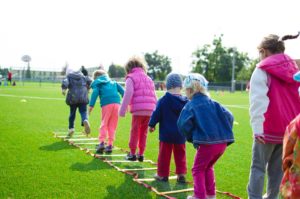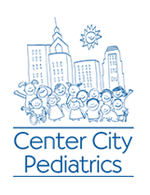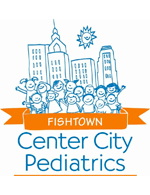In this guide to kids and exercise, our pediatricians explore the benefits of physical activity and some ideas to get moving!

Getting exercise is not as easy as it used to be. “In my day, I had to walk five miles back and forth to school every day, and that was uphill both ways, in the snow and on Saturdays!!” Sound familiar? Ok, ok, I am sure it was not that ridiculous. But, there is some element of truth. For many of us parents, as children, we tended to have more opportunities to get exercise, run around a lot and ride our bikes everywhere. Now, the school day has fewer gym periods, shorter recess and less physical effort getting back and forth. When school time is over, after school experiences might be physical, but many are not and we are less comfortable letting our kids roam the neighborhood freely on their bikes. If you take into consideration the amount of screen time some kids get, it means even less of a chance that they will be running around. In my home, I have noticed that my kids’ behavior becomes unbearable if they are stuck inside all day, or if, for some reason, recess and gym doesn’t happen at school.
Kids and Exercise: Why is it So Important?
Why is a big deal being made of physical activity? There are some obvious reasons, of course. There is the growing epidemic of obesity and unhealthy weight, by which almost every community is affected. As well, the collateral effects of unhealthy weight include early onset of diabetes, heart disease and hypertension. Regular exercise is known to improve heart and lung health, prevent high blood pressure and most importantly, control weight by reducing unhealthy fat. In addition, routine exercise will develop muscle and bone strength, which will benefit children as they grow into adulthood.
There are also the mental health benefits to consider. As children’s level of physical activity increase, so will their self-esteem and self-confidence. Since serotonin levels increase with exercise, the risk of depression and mood swings goes down. The natural release of endorphins will help concentration, focus and cognition. All of these changes allow for a greater sense of achievement, which will inevitably increase feelings of happiness.
The ‘why” get exercise is becoming increasingly clear. What about the ‘how’?
Different Types of Exercise for Kids
In my experience, there are two categories of exercise. There is the organized kind, and the non-organized kind.
The organized kind is ‘official’, and fits into what most think of as doing a sport. This is just what it sounds like. Signing your child up for a team sport, that usually involves anywhere from one to three days a week of going to practice or a game. This will require some expense and commitment of time. Children have a great chance to learn not only the skills of a given sport, but also the importance of commitment, team dynamics and supporting each other. Some of these team sports may involve more exercise than others. This is where I try to warn parents about realistic expectations. Not all sports are created equal. While baseball and softball are integral parts of the American experience, at the younger ages, these sports do not provide a significant amount of cardiovascular benefit. Sure, there may be a 5 or 10 minute run around the field, but there is also a lot of standing/sitting around for many children. This does not mean that it is not a real sport. It obviously is. But, it should probably be augmented with another activity in the course of the week that may involve more breathing hard and sweating a bit.
Now, non-organized exercise is very different. This can be something that an individual or small group might do, maybe just a parent and child. Just hang out at any playground, and you will see some serious exercise. Any time a person is really breathing hard, sweating and has a faster heart rate, you know they are getting exercise. If that type of activity can be sustained for 45 minutes to an hour, that is what I call success. Therefore, good exercise does not mean having to be on the basketball team or running a marathon. It just means maintaining some form of physical activity that enables you to breath hard and sweat a bit, eventually for 45 minutes. Another way is to take a vigorous walk on a regular basis. This is something most children can probably do. Take a walk around the block, but with some effort. This is not just a stroll. Breathe hard and sweat a bit. In the long run, try to make time for exercise like this a few days a week.
One more thing. The best way to help your child engage in more physical activity is to show them how important it is to you. Model for them, and share in the experience with them. Since time is such a precious commodity, sharing your time with your kids through exercise is a win-win for all of you.
Have fun, breathe hard, and sweat a bit.
 33 Rock Hill Rd
33 Rock Hill Rd 1740 South Street
1740 South Street 2365 East York Street
2365 East York Street